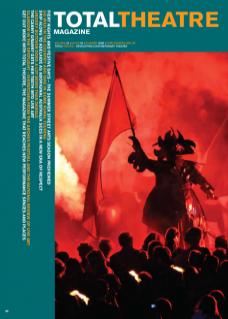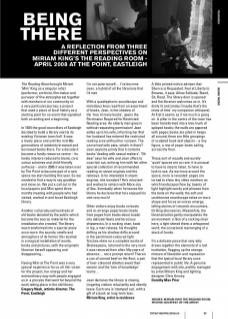The Reading Room brought Miriam ‘Mim’ King as a singular artist (performer, archivist, film-maker and purveyor of fine atmospheres) together with members of our community on a very particular journey; a project that used a piece of local history as a starting point for an event that signalled both an ending and a beginning.
In 1935 the good councillors of Eastleigh decided to build a library next to its existing Victorian town hall. It was a lovely place and until the mid-90s generations of residents browsed and borrowed books there. For a decade it became a family resource centre – its lovely interiors reduced to bland, civic colour schemes and child-friendly surfaces – and in 2006 it was taken over by The Point to become part of a new space we start building this year. So we needed to find a way to say goodbye and move on. We put a call out in the local papers and Mim spent three months meeting with people who had visited, worked in and loved Eastleigh library.
Another call produced hundreds of old books donated by the public which became the source material for the installation she created. The library was transformed into a special place once more: the sounds, smells and atmosphere of its former life recalled in a magical installation of words, books and pictures, with the enigmatic librarian herself appearing and disappearing...
Having Mim at The Point was a very special experience for us all. Her vision for the project, her energy and her extraordinary way with people engaged us in a process that went far beyond the work taking place in the old library.
Gregory Nash, artistic director, The Point, Eastleigh
I’m not quite myself… I’ve become Jean, a hybrid of all the librarians that I’d met.
With a quadraphonic soundscape and melodious lines read from an assortment of books, Jean, in the shadow of the ‘tree of many books’, opens the Permission Required for Restricted Reading area. An elderly man goes in without requesting permission! Jean sidles up to his wife, informing her that her husband has entered the restricted reading area without her consent. The concerned wife asks, what’s in there? Jean explains primly that it contains books ‘dealing with sexual matters’. ‘Oh dear’ says his wife and Jean offers to coax him out, enticing him with her other special collection of recommended reading on steam engines and the railways. Is he interested in steam engines, she wonders? He’s reluctant and wishes to remain with More Joy of Sex. Eventually when he leaves the library he declares that he’s enjoyed his visit very much!
Other visitors enjoy books on boats and re-arrange paper boats (made from pages from books about boats) into delicate fleets and ferocious shipwrecks. In a rocking chair, book in lap, a man relaxes, his thoughts drifting as his shadow drifts around in the parchment-coloured light. Torches shine on a complete works of Shakespeare, returned to the very room it was removed from after fifty years of absence… not a prompt return! There’s a can of corned beef on the floor; a pair of liver-coloured stilettos await their wearer and the ‘tree of knowledge’ looms…
Jean declares the library is closing. Lingering visitors reluctantly and silently leave. Each one is ‘stamped out’, with a gift of a book on long-term loan.
Miriam King, artist in residence
A little printed notice advises that Silence is Requested. Feel at Liberty to Browse, it says: Allow Solitude; Stand, Sit, Read. The library door is opened and the librarian welcomes us in. It’s dimly lit and smoky (‘maybe that’s the mists of time’ my companion whispers). At first it seems as if not much is going on. A pillar in the centre of the room has been transformed into a tree-trunk of splayed books; the walls are papered with pages; books are piled in heaps all around; there are little groupings of sculpted book-leaf objects – a tiny figure, a row of paper boats sailing across the floor.
These sorts of visually and aurally ‘quiet’ spaces are so rare; it is unusual to have to stop to listen, to have to look to see. As we move around the space, more is revealed: pages are turned to show tiny video monitors on which landscapes flow by; beams of light highlight words and phrases from the texts on the walls; the soft and unobtrusive soundscape takes on more shape and focus as voices emerge, telling stories of romantic encounters, thrilling discoveries. Meanwhile, the librarian/artist gently manipulates the environment: a flick of a rocking-chair here, a light shined there; a whispered word; the occasional rearranging of a stack of books.
It’s a delicate piece that very ably draws together the elements of a lost institution, flagging up the strange mixture of liberation and repression that the typical local library once represented in public life. A genuine engagement with site, prettily managed by artist Miriam King and lighting designer Chris Umney.
Dorothy Max Prior

